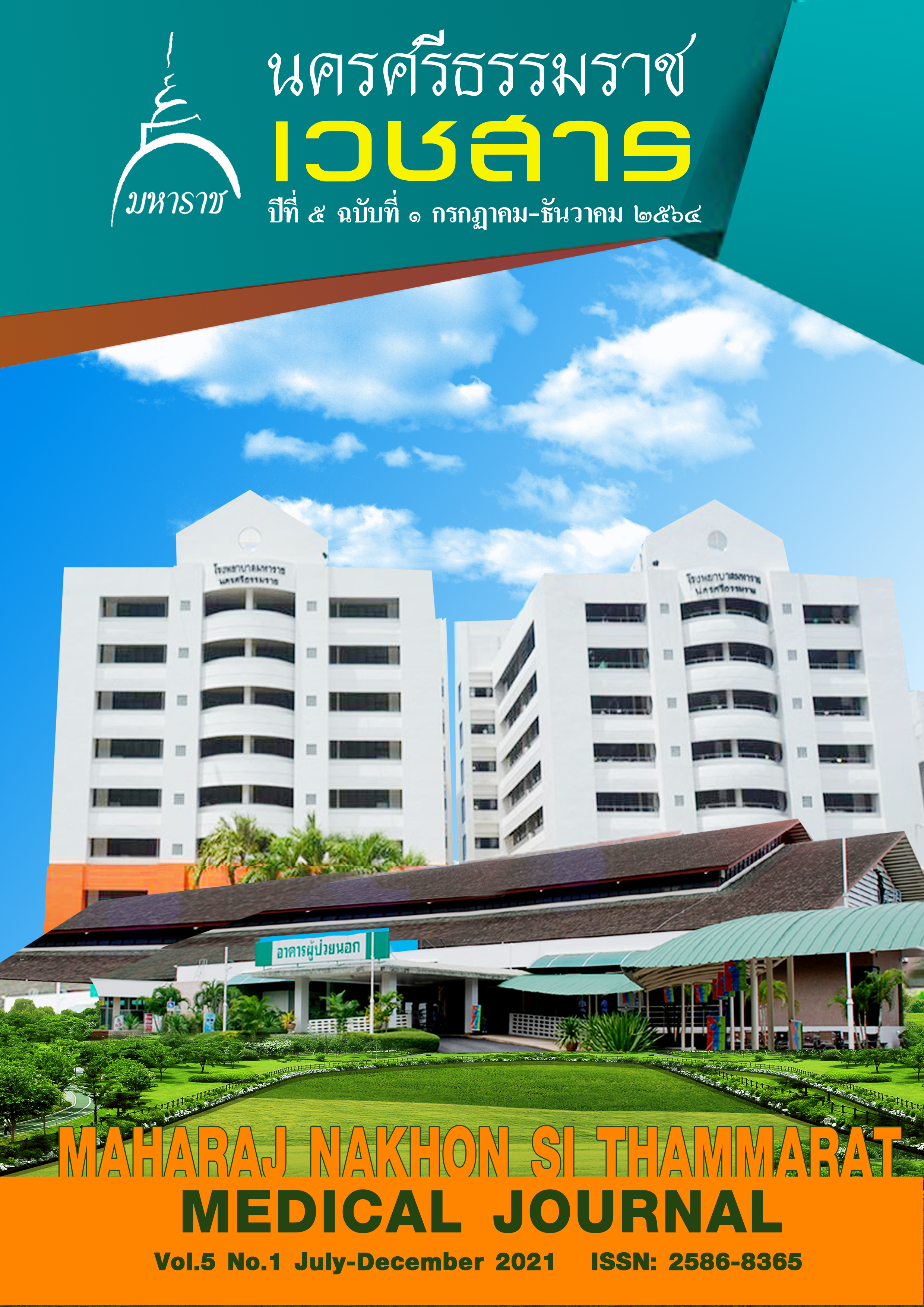การรักษาโรคผังผืดกดทับเส้นประสาทมีเดียนข้อมือด้วยวิธีการผ่าตัดบาดแผลขนาดเล็ก และทำลายเนื้อเยื่อน้อยในโรงพยาบาาราชนครศรีธรรมราช
คำสำคัญ:
ผังผืดกดทับเส้นประสาทมีเดียนข้อมือ, ผ่าตัดทำลายเนื้อเยื่อน้อยบทคัดย่อ
โรคผังผืดกดทับเส้นประสาทมีเดียนข้อมือ พบได้บ่อยมีความชุก 5% ในประชากรทั่วไป อาการแสดงได้แก่ชาที่นิ้วโป้ง นิ้วชี้ นิ้วกลางและครึ่งด้านในของนิ้วนาง หากไม่ได้ทำการรักษากล้ามเนื้ออุ้งมือโคนนิ้วหัวแม่มือจะลีบ อ่อนแรงเมื่อหยิบจับของแนวทางการรักษาโรคนี้มีทั้งวิธีอนุรักษ์นิยม ได้แก่ ใช้ยา ใส่อุปกรณ์พยุงข้อมือ กายภาพบำบัด และวิธีการผ่าตัด การผ่าตัดเปิดช่องอุโมงค์ผังผืดกดทับเส้นประสาทมีเดียนข้อมือแบบเปิดมาตรฐาน สามารถเกิดภาวะแทรกซ้อนเรื่องแผลเป็น ปวดแผลหลังผ่าตัดมาก มือยึดติดแข็งและใช้เวลาฟื้นฟูสมรรถภาพมือที่นาน การผ่าตัดส่องกล้องได้ผลลัพธ์ดีกว่าอย่างมีนัยสำคัญแต่ก็มีต้นทุนสูง และพบภาวะแทรกซ้อนที่อันตรายคือผ่าตัดโดนเส้นประสาท วิธีการผ่าตัดแบบบาดแผลเล็กทำลายเนื้อเยื่อน้อย ด้วยเครื่องมือ Minisure Kit และ Wongsiri technique เป็นทางเลือกในการแก้ปัญหาการผ่าตัดทั้งสองวิธีข้างต้น ได้ผลลัพธ์ที่ดี ภาวะแทรกซ้อนน้อย ต้นทุนต่ำ
เอกสารอ้างอิง
2. M. Bisaccia, G. Rinonapoli, G. Falzarano et al., “Clinical and radiological outcomes of distal radius fractures treated with orif with volar fixed-angle plates,” Euromediterranean Biomedical Journal, vol. 11, pp. 9–14, 2016.
3. M. Bisaccia, L. Piscitelli, G. Colleruoli et al., “Epidemiology of injuries and diseases due to overuse in rugby: observational study of the players of “Cusperugia Rugby”,” International Journal of Surgery and Medicine, vol. 2, no. 3, pp. 167–170,2016.
4. Lozano Calderón S, Anthony S, Ring D. The quality and strengthof evidence for etiology: Example of carpal tunnel syndrome.J Hand Surg Am,vol.33, pp.525 38, 2008.
5. Scangas G, Lozano Calderón S, Ring D. Disparity between popular (Internet) and scientific illness concepts of carpal tunnel syndrome causation. J Hand Surg Am,vol.33, pp.1076 80,2008.
6. Chung KC. Current status of outcomes research in carpal tunnel surgery. Hand (N Y), vol.1,pp.9 13,2006.
7. Jugovac I, Burgic N, Micovic V, Radolovic Prenc L, Uravic M, Golubovic V, et al. Carpal tunnel release by limited palmar incision vs. traditional open technique: Randomized controlled trial. Croat Med J,vol.43,pp.33 6,2002.
8. Okutsu I, Ninomiya S, Hamanaka I, Kuroshima N, InanamiH.Measurement of pressure in the carpal canal before and afterendoscopic management of carpal tunnel syndrome. J Bone JointSurg Am, vol.71,pp.679 83,1989.
9. A. ,oma, K. Veltri, T. Haines, and E. Duku, “A meta-analysisof randomized controlled trials comparing endoscopic andopen carpal tunnel decompression,” Plastic and Reconstructive Surgery, vol. 114, pp. 1137–1146, 2004.
10. H. S. Vasiliadis, I. Shrier, G. Salanti, and J. P. M. Scholten-Rob,“Endoscopic release for carpal tunnel syndrome,” Cochranedatabase of Systematic Reviews, vol. 31, no. 1, Article IDCD008265, 2010.
11. P. Cellocco, C. Rossi, F. Bizzarri, L. Patrizio, and G. Costanzo,“Mini-open blind procedure versus limited open techniquefor carpal tunnel release: a 30-month follow-up study,” Journal of Hand Surgery, vol. 30, no. 3, pp. 493–499, 2005.
12. S. Wongsiri, P. Suwanno, B. Tangtrakulwanich,V. Yuenyongviwat, and E. Wongsiri, “A new tool for miniopen carpal tunnel release - the PSU retractor,” BMC Musculoskeletal Disorders, vol. 9, p. 126, 2008.
13. S. Wongsiri, “,e new wave of carpal tunnel syndrome (CTS)surgery,” Bangkok Medical Journal, vol. 06, no. 1,pp. 80–85, 2013.
14. R. J. P. M. Scholten, A. Mink Van Der Molen,B. M. J. Uitdehaag, and V. H. Bouter LM De, “Surgicaltreatment options for carpal tunnel syndrome,” CochraneDatabase of Systematic Reviews, vol. 17, no. 4, Article IDCD003905, 2007.
ดาวน์โหลด
เผยแพร่แล้ว
รูปแบบการอ้างอิง
ฉบับ
ประเภทบทความ
สัญญาอนุญาต
เนื้อหาและข้อมูลในบทความที่ลงตีพิมพ์ในมหาราชนครศรีธรรมราชเวชสาร ถือเป็นข้อคิดเห็นและความรับผิดชอบของผู้เขียนบทความโดยตรงซึ่งกองบรรณาธิการวารสาร ไม่จำเป็นต้องเห็นด้วย หรือร่วมรับผิดชอบใด ๆ
บทความ ข้อมูล เนื้อหา รูปภาพ ฯลฯ ที่ได้รับการตีพิมพ์ในมหาราชนครศรีธรรมราชเวชสาร ถือเป็นลิขสิทธิ์ของมหาราชนครศรีธรรมราชเวชสาร หากบุคคลหรือหน่วยงานใดต้องการนำทั้งหมดหรือส่วนหนึ่งส่วนใดไปเผยแพร่ต่อหรือเพื่อกระทำการใด จะต้องได้รับอนุญาตเป็นลายลักษณ์อักษรจากวารสารมหาราชนครศรีธรรมราชเวชสาร ก่อนเท่านั้น



